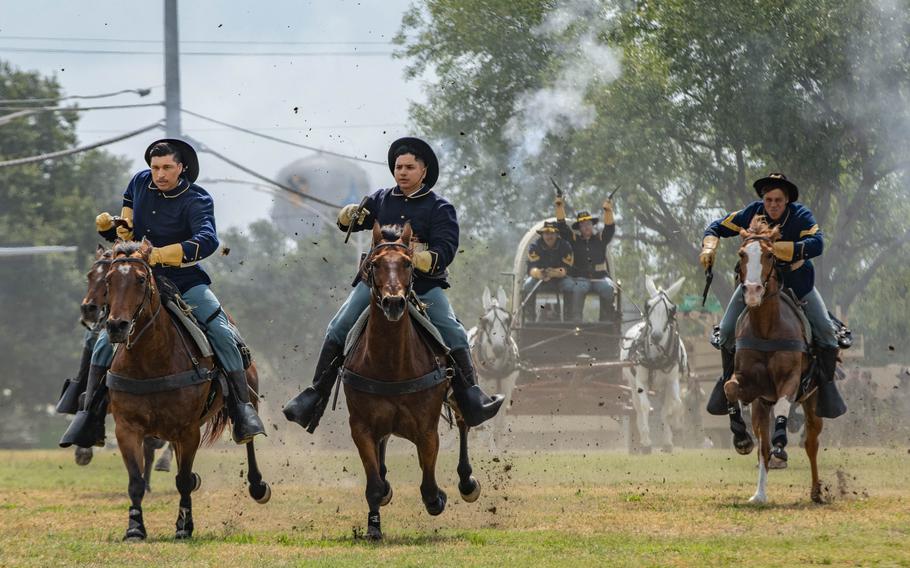
Army troopers assigned to the 1st Cavalry Division Horse Cavalry Detachment conduct a cavalry charge during a ceremony on Fort Cavazos, Texas, on June 5, 2025. (David Dumas/U.S. Army)
The Army is putting to pasture five ceremonial horse units that bring the service’s cavalry history from the Old West to life for communities across the country.
Service officials said the move will save $2 million annually and the money will be pumped into weapons and training.
“We’re doing this to align more resources with warfighting capability and readiness,” said Steve Warren, an Army spokesman.
More than 230 horses, mules and donkeys assigned to Fort Irwin, Calif., Fort Huachuca, Ariz., Fort Riley, Kan., Fort Sill, Okla., and Fort Hood, Texas, will be put up for adoption and transferred out of the Army in the next year.
Only the Old Guard caisson units at the Military District of Washington and Joint Base San Antonio, Texas, will remain active. These units participate in funeral services for Medal of Honor recipients, prisoners of war and those killed in action, and veterans ranked sergeant major or higher at Fort Sam Houston National Cemetery in Texas and Arlington National Cemetery in Virginia.
Each base is responsible for coming up with its own plan to close the unit and move soldiers from their assignment with a horse unit, Warren said. It is possible the horses could remain in the area to provide pomp and circumstance to events but outside of the Army’s budget.
“There may be work arounds. We don’t know. This is early days,” Warren said. “We’re not going to assign soldiers to the horse detachment any longer. We’re not going to keep horses at Fort Hood any longer.”
The budget cuts are part of an ongoing initiative in the Pentagon to rearrange funding to activities and costs that directly support warfighting. Defense Secretary Pete Hegseth has described cuts such as these as “refocusing and reinvesting existing funds into building the force that protects … the American people.”
It also follows a difficult period for the Old Guard stables in Virginia. It paused funeral honors for two years after the deaths of two horses in 2023 exposed unsanitary living conditions and a lack of open space for the herd to graze. The 3rd Infantry Regiment completely reformed its equine program and horse-drawn caissons returned to Arlington National Cemetery in May.
The Army’s other ceremonial horse units typically bring alive the history of the cavalry during weekly public demonstrations and unit ceremonies as well as during parades, rodeos and events throughout local communities.
The Fort Sill Artillery Half Section carries the traditions of World War I, while the 1st Infantry Division Commanding General’s Mounted Color Guard is reminiscent of Civil War-era soldiers. The three others all represent the Army of the late 1880s, using Colt revolvers and sabers of the era.
B Troop at Fort Huachuca is unique from the others in that it does not have any authorized personnel and instead relies on volunteers to fill its schedule of events for recruiting, community relations and Army ceremonies.
The 1st Cavalry Division Horse Cavalry Detachment at Fort Hood and Fort Riley’s mounted color guard have participated in presidential inauguration parades, while the Fort Hood detachment and the 11th Armored Cavalry Regiment Horse Detachment from Fort Irwin have walked the annual Pasadena Tournament of Roses Parade in California.

Members of the Military Funeral Honors-Caisson Platoon from Joint Base San Antonio-Fort Sam Houston participate in a funeral procession at Fort Sam Houston National Cemetery in San Antonio, Texas, in November 2023. (Rose L. Thayer/Stars and Stripes)
Fort Riley’s color guard participated in 143 events in 15 states and two countries in 2024, said Maj. Guster Cunningham, spokesman for the division. On average, about 30 soldiers are assigned to the unit at any given time, working alongside its 18 horses, two draft horses and four mules.
“We will work diligently to find suitable homes for our horses and will keep the community informed throughout this transition,” Cunningham said. “This change does not impact the 1st Infantry Division’s (“Big Red One”) core priorities: building warfighting readiness, caring for soldiers, civilians, and families, adapting our formations to win, and developing inspirational leaders. We remain committed to strengthening partnerships and engaging with our surrounding communities.”
The Fort Hood detachment, with roughly 40 soldiers, now owns 29 horses and four mules, according to the 1st Cavalry Division. At division ceremonies, the soldiers typically close the event with a cavalry charge, complete with the mule-drawn Studebaker wagon and Apache helicopters overhead.
Service officials said they aim for a seamless transition for the horses to responsible owners.
“The 1st Cavalry Division Horse Detachment has been a proud symbol of the division’s heritage for over 53 years, playing a vital role in community relations and representing the division and the Army with distinction at national events, including the Army’s 250th birthday parade. The 1st Cavalry Division remains committed to its mission of warfighting readiness and service to the nation while honoring the legacy of our horse detachment,” the division said in a statement.
Other units affected by the change did not respond Tuesday to a request for comment.
Each unit will have six months to create a plan to close the horse units, and then each will spend the next six months executing the plan, Warren said. The horses will not be sold, he said.
“We’re not trying to try to make money here. We’re going to donate them, find adoption for them,” Warren said. “Just like our military working dogs, they are part of the Army. They’re part of the Army family. We’re going to treat them with compassion.”